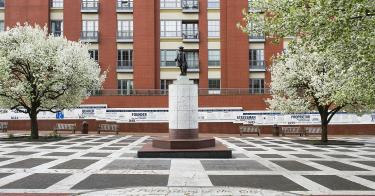The National Park Service recently announced a plan to rehab the dilapidated Welcome Park in Philadelphia, which marks the spot of William Penn’s home. The proposed project would have included removal of the park’s central statue of Penn. Despite his status as the state’s founder, he was set to disappear—ironically enough, in the name of inclusivity, the latest historical figure to be tarred as an oppressor.
However, it seems the forces of cultural progressivism had finally gone too far. Swift, bipartisan outrage greeted the new plan. Four days later, the NPS reversed it, saying it was released prematurely. Pennsylvania’s Democrat Gov. Josh Shapiro went further, stating definitively that Welcome Park would remain the statue’s home.
It’s a welcome retreat. What the NPS proposed is not an improvement. It would have been a modern act of vandalism that aimed to rewrite the very history this monument commemorates.
>>> America Must Reclaim What the Left Has Attempted to Destroy
Penn is a pivotal figure, especially in the state that bears his name. Penn (1644-1718) fled religious persecution after his conversion to Quakerism. He arrived in America in 1677 aboard the Welcome, which gave the park its name, and eventually received the “province” that became Pennsylvania in the settlement of a debt that Charles II owed Penn’s father.
Penn is perhaps most famous for his engagement with Pennsylvania’s Native American population, primarily the Delaware tribes. He legendarily met with them at Shackamaxon under an elm tree to establish a formal treaty. And under the governing statutes he established for Pennsylvania, they were granted formal legal protections.
Although Penn’s power in his province was granted by the British king, he did not govern as a royal. A passionate proponent of religious freedom, he established a free system of governance that anticipated that of the United States. The First Amendment of the Constitution is, in fact, deeply reliant on Penn’s principles. Taken as a whole, his contributions to Pennsylvania and the future United States were monumentally constructive, positive and deserve special commemoration.
Sadly, as Penn’s later years were plagued by financial troubles and ill health, he did not live to see the success of his province, but his legacy in Pennsylvania endures. In 1982, on the 300th anniversary of the incorporation of the Province of Pennsylvania as a royal colony, the sight of his Philadelphia home Slate Roof House was chosen for a park to honor him. The house itself vanished in the 19th century, but the renowned Philadelphia firm of Venturi Scott Brown was hired to design an installation celebrating Penn, and in 1984 President Ronald Reagan marked the occasion by proclaiming Penn and his wife, Hannah Callowhill, honorary citizens of the United States.
>>> Reclaiming Museums’ Civic Duty
The centerpiece of the park is a maquette, or miniature, of Alexander Milne Calder’s monumental bronze William Penn (1888-94) on top of Philadelphia’s City Hall. At 37 feet high, William Penn is the tallest statue atop a building in the world and has long been the personification of the city Penn founded. The small-scale version in Welcome Park has been an opportunity for visitors to see the distant and towering statue in an intimate and personal way, as would be appropriate in the context of the park on the site of Penn’s home. Its removal in the name of presenting an alternative revisionist history of Philadelphia would be a sad loss.
Philadelphia is not an inviolable museum but rather a vibrant modern city in which things can and will change. The installation of Welcome Park was such a change 40 years ago. No one would debate that the site now requires significant renovation, but it is an important installation with deep Philadelphia roots that should be enhanced, not eradicated.
The public outrage provoked by NPS’ Cultural Race Theory-driven reflexive impulse to perceive William Penn as an oppressor no matter what his personal beliefs or actions may have been is a welcome sign that this corrosive philosophy that has done so much damage to our cultural and academic institutions can be defeated.
But this is far from the end of the battle. Congress must prohibit any funds being used to eradicate history. Moving forward, all who value American history—yes, even with its bumps and bruises—should be emboldened to decisively and quickly reject the progressive extremists determined to erase it.
This piece originally appeared in MSN


